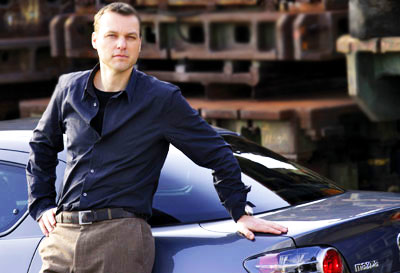Two circles and three lines sketched on a piece of paper are projected on a large screen flanked by two next-generation Mazda 3s. The similarities between the simple line drawing and the cars are unmistakeable. Mazda’s head of design and creator of the new 3, Laurens van den Acker, takes centre-stage in a room full of Aussie journos, gesticulating expansively as he explains his inspiration and ideas. Although the Mazda 3 sedan and hatch have just been unveiled, a fortnight before their official global reveal in Detroit, they take a back seat to van den Acker’s simple line drawing.Even though the room is dark, it’s like a light switch has just been flicked on.Mazda Australia’s first design forum, held last night at the VCA in Melbourne, was a fascinating insight into the trendsetting Japanese car-maker’s present and future design direction.Van den Acker is the man behind the dramatic Nagare series of concept vehicles. He was appointed General Manager of Mazda’s Global Design Division in 2006 after seven years with Ford. In two short years he has steered the company’s four studios and 300 designers towards a bold new aesthetic.For the essence of design philosophy is simplicity, to take away the visual distractions and focus on the pure form. The amazing Le Mans prototype car, Furai, is a perfect example of complex, chaotic design, inspired by the wind. The antithesis of design, if you will.And Nagare is the basis for the future generations of Mazda vehicles: its elements already showing up in the organic, shaped sheetmetal, tactile interiors and swooping front end and headlights of the new 3.As he shows us through the inspirational slides of sand dunes and wind-pummelled rock formations, the relationship between nature and Nagare is obvious. Especially in the amazing interiors, which are generally underrated by the media and difficult to appreciate on a raised show stand, anyway.The more subtle movements and forms that have filtered into the new generation of Mazda vehicles then become more apparent. The curved, organic grille – so different from the previous car’s, and on closer inspection different again between the 3’s sedan and hatch bodystyles. The shapely rear end, squared off and aero friendly thanks to tricky horned tail-lights that fill the space without affecting the ovoid design and shape.Does this mean the current generation is a stepping stone to full-blown Nagare-inspired production cars, like a warm-up before the big game?The 3 is indeed a very different car, as the 2 and 6 were before it. But without taking too many risks. In this generation, anyway.“The important question in design is: does it communicate?” Van den Acker says.“We are building on the success of the previous generation, and you have to be a little conservative, to ensure the driver can jump in and drive it straight away without confusion. Add even two new buttons, and it can upset people. It needs to be progressive.”“However, we want to be free to explore and take risks. The philosophy that you don’t do something unless it has a purpose sounds too German.”Van den Acker’s analogies are priceless: he dislikes the constraints and weight of passive and active safety in cars, likening it to a person always carrying around a 60kg backpack for the one day he or she may be pushed out of a plane. He is excited about the future of safety technology, of cars ‘talking’ to each other to avoid collisions, and exterior airbags turning the highways into nothing more dangerous than bumper cars at the fair.He admits that while designer never have enough money to do what they want, they “…need to put these small bags of money in the right places”. The Volvo S40 serves as an example; so much money went into creating the beautiful floating console, that it draws the attention away from the hard surfaces of the doors and sills.He acknowledges that when it comes to the emotion of motion, of designing cars, that designers haven’t even started to touch on the possibilities.The evening ends with a short, fast-paced teaser commercial for a Mazda 3. Its large wheels and bonnet scoop give it away – yes, the next 3 will have a more efficient, more overt bonnet air scoop for its turbo.Van den Acker looks like he has tasted something unpleasant when asked about possible parallels to the newer Subaru Impreza WRX, which at some angles looks very similar to the current 3. He’s already fielded questions about similarities between the new 3 and Peugeot’s smiling grin and swooping headlamps.But he maintains that the more pronounced styling fits in with the new 3 philosophy of the naughty middle brother, cheeky and mischievous, sitting in between the ‘younger’ Mazda2 and ‘mature’ Mazda 6. The last 3MPS was “…not bold enough”, and with no 6MPS, the Q-car subtlety no longer applies.And with Nagare, subtlety takes a back seat to striking form and memorable features. Something already exercised years ago at Mazda in the iconic RX-8.In this dark time for the car industry, it seems that the light is still shining at Mazda.FEEL THE FURAIVan den Acker likened the body design of Furai to a flag blowing in the wind – taut at the front, with chaotic movement towards the tail.And had the budget been greater, he says, the Furai may not have existed.“If we had $2million, we may have built something else instead of Furai, but race cars are easy,” he said.“You don’t have to put too much into the interiors, as they are stripped-out sports cars. They are not only aspirational, but also cheaper to do.”And we may yet see if the Furai has the goods to match its beautiful body. The car is built on an existing race platform, and both Audi and Porsche have just pulled out of the ALMS race leaving Acura … and Mazda.





